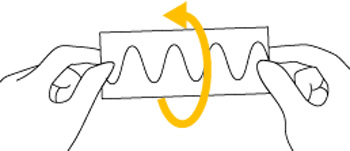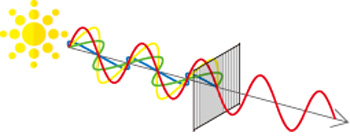Is it a particle or a wave?
Is it both, or perhaps neither?
Light possesses the propertiesof both particles and waves. It's a phenomenon that can't be fully explained simply by addressing whether it's a particle or a wave.
Light has long since fascinated people, and it has plagued many scientists in their attempts to unravel its mysteries.
Optical rotation is one phenomenon of light, where light passes through a substance and depending on the substance, the light rotates.
Substances and compounds which contain properties that cause light to rotate are called "optically active" substances.
Light rotates to the right or to the left, as well as at various angles, depending on the substance.
We can discover certain things about a particular substance from its angle of rotation.
Polarimeters are used to measure angle of rotation.
Light exhibits a "wavy" quality, in which it oscillates as it moves along.
When this wavy light passes through a substance, a phenomenon occurs wherein the direction of the undulating, wavy light rotates.
This is the optical rotation of light.
Using this as a basis, let's try to explain optical rotation with an easy to understand, metaphorical illustration.
Draw a wavy line on a long piece of paper.
Hold the center of both ends of the piece of paper firmly with your fingers. Turn it around at all sorts of angles.
This oscillating wave that moves in the direction of many angles, which is a deeply complicated phenomenon entangled with other matter is natural light. It is the normal state of light.

The angle of rotation of light can't be measured in this state.
The oscillating waves of light move at each and every angle, so it is impossible to determine which wave passes through a substance and to what degree it rotated.
As such, this light that moves at many angles and oscillates as it travels along must be limited to move in the direction of one angle.
In order to achieve this, light is passed through something called a "polarizer."
A polarizer has a grid-like pattern, arranged in an intricate, alternating fashion of lines that light does not pass through and spaces that light passes though.
The light is obstructed by the polarizer which enables only a single wave of light moving at one angle to pass through. This is called "polarized light."

When two polarizers are placed one after the other and only one is made to rotate, this creates an angle that completely blocks out the light.
This is because the light, which has passed through the first polarizer and has been constricted down to a single wave moving at one angle, is blocked by a second polarizer of a different angle.
By rotating the polarizer (the second polarizer in a polarimeter is called an "analyzer") and finding the angle at which the polarized light passed through, or the angle at which it was blocked, it is possible to measure the angle at which the light passed through a substance (the angle of rotation).
Polarimeters use this principle to measure the angle of rotation of a substance.
Polarimeters are instruments used for measuring the angle of optical rotation of light.
General polarimeters contain mechanisms such as a light source and polarizer. Light emitted from the light source passes through the polarizer and the angle of the wave of light is restricted. The angle at which the light rotates is measured when it passes through the substance.
During measurement, if the plane of vibration which faces the light source appears to be rotating clockwise, it is dextrorotatory. If it appears to rotate counter-clockwise, it is levorotatory.
Dextrorotatory comes from the Latin word "dextro" meaning, "right." "d-rotary" can also be used to refer to dextrorotatory. "Levorotatory" comes from the Latin word "levo" meaning, "left."
Levorotatory is also known as "l-rotatory. The system for denoting optical isomers (enantiomers), either d- or l-, is derived from these words.
Polarimeters are largely used in the sugar refining and pharmaceutical industries. In the sugar refining industry, polarimeters are used to determine the type of sugar or to ascertain the purity.
In the world of pharmaceuticals, there are many cases where chemical compounds may be subjected to certain standards, depending on the angle of rotation. Polarimeters are used to perform checks such as determining the type of substance.
In regards to polarimeters, when it comes to the optical rotation of light, "polarizers" sound like a difficult concept that's hard to imagine. However, polarizers are surprisingly used in various places throughout everyday life.
Polarizing filters for camera lenses are a must in order to take pictures that come out exactly how you'd like.

Many of us have experienced being blinded by the glaring brightness of the outdoors when on a snowy mountain, doing water sports, or fishing. Polarizing film controls reflected light from the surface of snow and water, and allows only the necessary amount of light to penetrate. It is commonly used in these types of leisure activities and sports.

LCDs have two polarizers (polarizing filters). In order to display a clear, vivid image, they control the light which passes in various directions to produce light that passes in only one uniform direction.


